THE average age of farmers and fisherfolks in the Philippines is 57 years old. That was established by the Department of Agriculture’s (DA) Agricultural Training Institute (ATI), a few years ago. Back then, it noted that most of the young in the countryside were migrating to the cities. They are not interested in farming anymore.
I bring this bit of recent history back to mind as farming is indeed slowly dying. This is apparent if you visit the countryside today. More farms are abandoned, if not converted to other uses.
This reality becomes all the more disturbing each day.
The young are migrating to the urban areas to pursue lucrative jobs in commercial centers. As farming has long been associated with poverty, parents encourage and advise their children to find jobs or pursue other livelihood occupations besides farming.
So in a nation whose farmers are aging, the lack of interest by the young to engage in farming depletes the pool of current and potential labor force who produce and feed the nation.
This trend is not only noticeable in the nation’s farms.
As early as 2013, the Philippine Institute for Development Studies and the Philippine Council for Agriculture, Aquatic and Natural Resources Research and Development sounded the alarm on the declining enrollment in agriculture and related courses by an average of 1.5 percent every year.
The full implications of these twin developments (decline on the number of farmers and experts), for an import-dependent nation to meet its food demand or fill food shortages is that it exacerbates food insecurity.
The discussion on the plight of farmers and fisherfolks in the Philippines is rather long. Poverty in agriculture and studies by experts on the subject fill our libraries and the daily pages of the nation’s papers along with rising criminality throughout the decades. It has been part of the theme of expert conferences, and seminars and workshops of rural and agricultural development operatives since after the Second World War.
The expert findings and discussions boil down to the realization that we are an agricultural country and yes, the sector is the least productive in terms of its contribution to the economy, even if for a long time, more than 70 percent of the population depended on agriculture as their main source of livelihood and income.
It is too late to do something about our current farmers. But can the mindset of the younger generation be changed? Can we make farming appealing to them as an occupation?
That is way far ahead and political will is essential to solving the problems of agriculture in the Philippines. But yes, now is the time to act besides holding more conferences, workshops, and talks regarding agricultural problems in the country.
Free irrigation and other subsidies, for instance, is a step in the right direction taken by the current administration on making farming vibrant and its workers and stakeholders younger.
It is inspiring to note that it is also implementing a credit service program for farmers that is almost interest-free called the Production Loan Easy Access (Plea). Some farmers who had Plea loans utilized it to modernize their operations.
Our experts and policy-makers have written and discussed topics about our farmers and fishermen as among the poorest for far too long. Compared to other countries in Asia, our farmers and fisherfolks earn the lowest net income per year. Besides irrigation, fertilizers and seeds which are expensive production inputs must be fully subsidized like it is done in China, India, Indonesia, Thailand, and Vietnam.
Prioritizing support to agriculture, through increased funding, is an indication of the commitment of the government to strengthen the nation’s weakened agriculture, and help its constituents in the sector who are struggling to sustain food security in a country that is constantly threatened by natural and man-made calamities.
This administration, has so far, increased if not sustained its high budget support to agriculture, particularly for rural and agricultural infrastructure. It has to do more now to ensure the future of farming in the country.
If government focuses its resources to improving agriculture, it can yet make the countrysides teem with productive agricultural industries, livelihoods, and communities once more.












